mobile View, to the German Version tap the flag
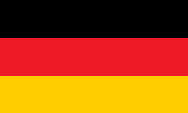

- Autonomous Region of Spain and historical region in France
- Kingdom until 1841
- own names:
– Spanish: Navarra
– Basque: Nafarroa
– French: Navarre
• Flags
• Historical and other Flags
• Meaning/Origin of the Flag
• Coat of Arms
• Historical Coats of Arms
• Meaning/Origin of the Coat of Arms
• Map of the autonomous regions of Spain
• Map of the historical Kingdoms on the Iberian Peninsula
• Numbers and Facts
• History
• Origin of the Country's Name
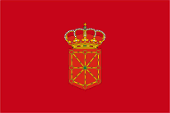
since 1910,
Flag of Navarre,
ratio = 2:3,
Source, by: Flags of the World





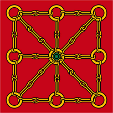
since 1910,
Banner of Navarre,
ratio = 1:1,
Source, by: Flags of the World




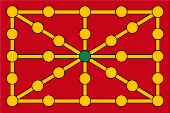
12th/13th century,
alleged flag of Navarre,
Source, by: Wikipedia (ES)



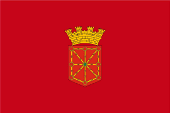
1931–1937,
Flag of Navarre,
Source, by: Wikipedia (ES)



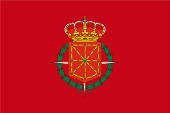
1937–1981,
Flag of Navarre,
Source, by: Wikipedia (ES)




The flag of Navarre is plain red and shows the coat of arms of Navarre in the centre. The flag was introduced on 15th of July in 1910, along with a square banner of arms for ceremonial occasions. The flag was modified several times. In 1931 (Spanish Republic), the royal crown on the shield was replaced by a mural crown. After the end of the Republic in Navarre, the royal crown was reintroduced in 1937, but with the addition of a green wreath and the cross of San Fernando. The flag remained unchanged in this form until 1981, when the current design was introduced. This flag was adopted by law for the autonomous community of Navarre with the adoption of the Statute of Autonomy on 10th of August in 1982. Strangely enough, there are discussions in the country about whether a flag of Navarre even existed before 1910. The General Charter of the Kingdom of Navarre in the 13th century already stipulated what the king's seal, coin stamps and banner should look like. In feudal times, the coat of arms or banner were associated with the person of the feudal lord, not with the country or even the nation. As trade flourished, became international and transcontinental, as naval powers began to conquer the world, it became important to create distinguishing marks for ships. They had to show the colours of the country, the city or even the feudal lord, but in a simplified, optimised form that made it possible to distinguish them at great distances. The flags and pennants of the ships were kept simpler in terms of colour and design. It was not until the Napoleonic era that the national idea began to blossom. The inhabitant, countryman or citizen found a new identity, which began to detach itself from the person of the prince and turned towards the country, state or even the nation. The old banners made way for simple banners and flags – often with only a few structures or colours, and stood for common interests or identities. In addition, they suddenly had to be available en masse and therefore quick and easy to produce. In this respect, in the centuries before 15th of July in 1910, as in all other countries in the world – only one hundred years earlier – there could have been no national flag, only the royal banner. However, as described above, this is not unique. Historical texts repeatedly describe the banner of Navarre as a red flag with golden ribbons or chains. The depiction of chains is first described in 1423. Before that, a similar construction of golden bars and balls was used, which is known as the "pomegranate gold carbuncle". The flag of the ancient kingdom was, as was customary at the time, a flag of arms. That is, a flag that showed the image of the coat of arms of the country (actually the ruler). Consequently, the flag bunting is plain white with a red / purple lion in the center. In this early period of flags, they were actually not shaped like our flags today either. The flags were more like coats of arms, which were attached to the mast with the straight side.
Source: Wikipedia (ES),
Volker Preuß


since 1910,
Coat of arms of Navarre,
Source, by: Wikipedia (ES)

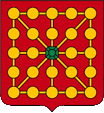
from ca. 12th century,
Heraldry of Navarre,
Source, by:
Wikipedia (ES)
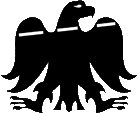
from ca. 13th century,
Heraldry of Navarre,
Source, by:
Wikipedia (ES)
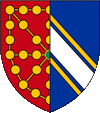
1234–1285,
Dynasty of Champagne,
Coat of arms of Navarra,
Source, by:
Wikipedia (ES)
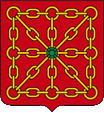
from ca. 15th century,
Heraldry of Navarre,
Source, by:
Wikipedia (ES)
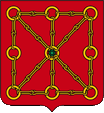
from ca. 19th century,
Heraldry of Navarre,
Source, by:
Wikipedia (ES)
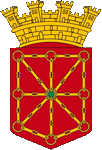
1931–1937,
Coat of arms of Navarre,
Source, by:
Wikipedia (ES)
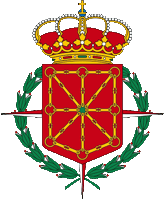
1937–1981,
Coat of arms of Navarre,
Source, by:
Wikipedia (ES)

The coat of arms of Navarre shows a plain red shield with a combination of a straight and a diagonal cross and a surrounding border formed by gold chains, with an emerald in the centre and above it the royal crown, the symbol of the Old Kingdom of Navarre. It was redefined in 1910 in connection with the creation of the flag and used until 1931. In that year (the period of the Spanish Republic), the royal crown was replaced by a mural crown, which was replaced again in 1937 by the royal crown, but with the addition of a green wreath and the cross of San Fernando. The coat of arms remained unchanged in this form until 1981, when the current design was introduced. This coat of arms was adopted by law for the autonomous community of Navarre with the adoption of the Statute of Autonomy on 10th of August in 1982. The coat of arms dates back to the middle of the 12th century, to King Sancho VI of Navarre (1150-1194). However, at this time the red shield was not yet covered with the golden chains, which only came into use at the beginning of the 15th century. It was a similar construction, but consisting of golden bars and balls, which is known as the "pomegranate gold carbuncle". However, King Sancho VII initially used a different symbol, primarily as a seal. This was the Arrano Beltza, the black eagle. Theobald, his successor and nephew, Count of Champagne, reigned as King Tybalt I. from 1234 to 1253. He again used the "pomegranate gold carbuncle", but combined it with his own haraldry as Count of Champagne. This was repeated again and again, depending on which noble house ruled the kingdom, until 1512, when the reign of the House of Navarre-Foix-Albret ended as the last separate line. The land was then divided into Upper Navarre and Lower Navarre and passed to the Spanish and French kings respectively.
Source: Wikipedia (ES),
Volker Preuß

The autonomous Regions of Spain:
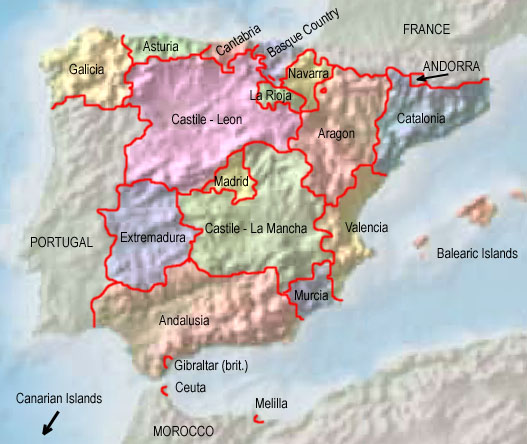
Source: Freeware, University of Texas Libraries, modyfied by: Volker Preuß

Map of the historical Kingdoms on the Iberian Peninsula (ca. 1220):
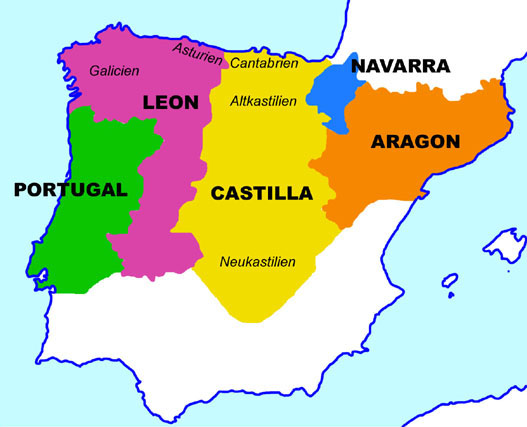
Map: Volker Preuß

Area: 4.010 square miles
Inhabitants: 664.117 (2022), thereof 80% Navarrese Castilians, 15% Basques
Density of Population: 166 inh./sq.mi.
Capital: Pamplona (Iruñea), 203.418 inh. (2022)
official Languages: Spanisch, Basque
Currency: Spanish (Euro) currency
Time Zone: GMT + 1 h
Source: Wikipedia (DE)

antiquity · settlement by the iberian tribe of the Basques (Vascons)
ca. 600 B.C. · immigration of Celts, the Vascons become by mix with the Celts to Celtiberians, the today's Basques
218–201 B.C. · Second Punic War, the Roman Empire acquires the possessions of Carthago in Iberia, subjugation of whole Iberia until the year 19 B.C., Roman settlement, romanization, the today’s Navarre comes to the Roman province of Hispania Tarraconensis
ca. 400 A.D. · Great Transmigration (Migration Period), immigration of Alans, teutonic Suebs and Western Goth
714 · from northern Africa coming Arabs conquer Navarre
778 · the Frankish Empire under Carl the Great conquers Navarre, establishment of the Spanish Mark in the foreland of the Pyrenees Mountains, but defeat against the Basques in the Valley of Ronceval
795–812 · re-establishment of the Spanish Mark by Carl the Great and his son Ludvig the Pious
812 · liberation of Pamplona Town from the Arabs by the Basques, establishment of the Kingdom of Pamplona
816–851 · reign of Iñigo Arista over Pamplona
827 · unsuccessful revolt of the der Basques against the Frankish Empire, Pamplona becomes a part of the Spanish Mark as a county
905 · Sancho Garcia, elected to the Count of Navarre (County of Pamplona), nominates itself to the King of Navarre and enforces the independence from the Frankish Empire
905–925 · King Sancho of Navarre liberates the areas northern Ebro River, parts of the today's Aragon and parts of Castile from the Arabs
925 · death of King Sancho
1001–1035 · times of the rule of Sancho III. (the Elder), after his death the kingdom becomes shared under his four sons: Garcia earns Old-Navarre and Biscaya, Ferdinand earns parts of Castile, Ramiro earns Aragon, Gonzales earns Tudela
1076 · king Sancho Ramiro of Aragon overthrows king Sancho IV. of Navarre and unites both empires
1134 · death of king Alfons I., Navarre becomes an independent kingdom again
1200 · ceding of territories to Castile
1234 · death of king Sancho VII. of Navarre, with this fact vanishes the dynasty of Sancho in Navarre, the heritage goes to Thibaut of Champagne
1285 · Johanna of Champagne, the last heiress of the house, marrys king Philipp IV. (the Pretty) of France from the house of the Capetians
1328 · death of king Ludvig X., vanish of the main-line of the Kapetings, Johanna II. the daughter of Ludvigs X. inherits Navarre, her consort Philipp III. Count of Evreux becomes in this way King of Navarre
1332 · ceding of territories to Castile
1375–1379 · war of Navarre (under Carl II. [the Evil], son of Philipp III.), Wales and Aragon against France and Castile, Navarre becomes ravaged
1379 · ceding of territories to Castile
1445 · Blanca, the granddaughter of Carl II., marrys King Johann of Aragon, both kingdoms get united
1479 · death of King Johann of Aragon, the heritage goes to his daughter queen Eleonore, married with Gaston Count of Foix and Vicomte of Béarn (Aragon is bond with Foix and Béarn)
1484 · Johann of Albret (Jean d'Albret) gets Kingdom of Navarre by marriage
1510 · ceding of territories to France
25th of July 1512 · queen Catharina, the granddaughter of Johann of Albret, loses Upper-Navarre (the today’s Spanish Navarre) in the war to the Kingdom of Spain, however Upper-Navarre continues important privileges as an own kingship within Spain
1517 · Henry II., son of King Johann of Aragon, becomes King of Navarre (Lower-Navarre, the today’s French Navarre)
1521 · death of King Ferdinand of Spain (consort of Isabella of Spain), Henry II. trys unsuccessfully to acquire Upper-Navarre
1527 · Henry II. marrys Margarete of Valois, the sister of king Franz I. of France
1581 · ceding of territories to France
August 1589 · King Henry III. of Navarre, grandson of Henry II., becomes King of France, Navarre (Lower-Navarre) becomes united with France
1789 · French Revolution, momentary abolition of monarchy, end of the independent kingship of (Lower-)Navarre
1790 · Navarre and the County of Béarn become united to one departement (Basse-Pyrénées)
1808–1813 · Upper-Navarre is occupied by French troops
1814–1830 · Kingdom of France under the Bourbons, nominal: "Kings of France and Navarre"
1830 · the Kings of France take off the title "King of Navarre"
1839 · death of the last King of (Upper-)Navarre
16th of August 1841 · Upper-Navarre becomes completely affiliated as Province of Pamplona to Spain, but it continues important privileges
1874 · abolition of the last privileges of Upper-Navarre
1936–1939 · Spanish Civil War, Navarre fights with its own militia "the Requetés" on the side of the troops of General Franco against the socialistic central government
1982 · Navarre gets the statute of autonomy within Spain (former Province of Pamplona), establishment of the "Autonomous Community of Navarre" (Comunidad Foral de Navarra)
Source: Wikipedia (ES),
World Statesmen,
RetroBib Retrobibliothek,
Volker Preuß

The origin of the name "Navarre" is not clear, probably it has its roots in a basque word, because in the middle ages in Navarre was spoken solely Basque.
Source: Wikipedia (ES)


![]()


























